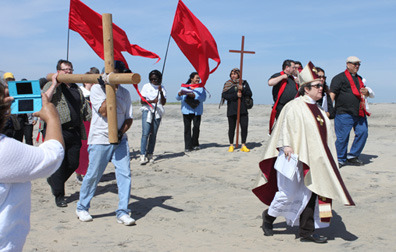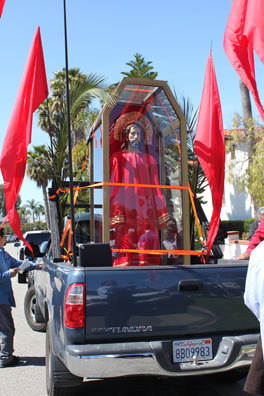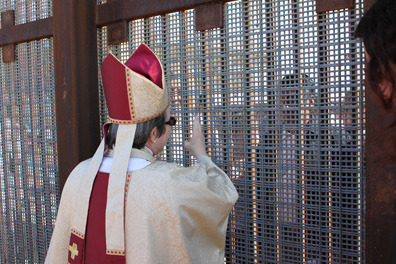
Bishop Diane Bruce of the Diocese of Los Angeles was among the pilgrims who walked a Via Crucis (Way of the Cross) route to the U.S.-Mexico border. Photo/Janet Kawamoto
Two 20-foot-high steel walls between Tijuana and San Diego made seeing each other difficult and touching each other all but impossible, but they couldn’t stop Episcopalians and Anglicans on both sides of the border from celebrating the Eucharist together April 2.
The display of unity aimed a spotlight at the plight of the undocumented and on unjust immigration laws that separate and divide families, said Bishop Suffragan Diane Bruce of the Diocese of Los Angeles and Bishop Jim Mathes of the Diocese of San Diego.
With U.S. Border Patrol helicopters circling overhead, the two bishops blessed bread and wine at a 3 p.m. service on the U.S. side of the border at Friendship Park in San Diego. A few yards away, across the border wall, clergy from the Anglican Church of Mexico did likewise.
“What a wonderful way to celebrate this Monday in Holy Week,” said Bruce afterwards. “At the end of the service, people (from the Mexico side) were coming up individually to the border wall and asking for blessings.
“It pushed me over the edge, in making me understand that there are no walls that can separate us from God’s loving grace. There is no border that can do that.”
The border was the fourth and final stop in a multi-city “Via Crucis” (Way of the Cross) pilgrimage that began at 8:30 a.m. at MacArthur Park in Los Angeles. There, after praying the first three Stations of the Cross, about 40 pilgrims formed a caravan of cars.
Their procession followed a 6-foot wooden statue of Jesus in a pickup truck some 130 miles southward along the Interstate-5 freeway, adding more pilgrims and praying progressive Stations of the Cross in Spanish and English at designated stops in San Clemente and Chula Vista before reaching the border.

A Salvador del Mundo (Savior of the World) figure, originally from El Salvador and usually housed at Trinity Episcopal Church, Los Angeles, accompanied the Via Crucis pilgrimage. Photo/Janet Kawamoto
“Today for us as Christians is one of the holiest times of our year — Holy Week — and we are telling the story of the oppression of our Lord Jesus Christ,” said the Rev. Liz Muñoz, rector of Trinity Church in Los Angeles, and a pilgrimage organizer.
“Many of us believe that Jesus was an immigrant from heaven to earth,” she told those gathered at MacArthur Park. “He came from heaven without documentation to teach us to love God and to love one another.
“We come today together to pray for just immigration laws that will allow families that have been together to continue to be here together, to participate and be loved just as everyone deserves to be loved in this country.”
Indicating the gold-crowned statue of Jesus, wearing a brilliant red robe, inside a glass booth in the back of the pickup truck, Muñoz continued: “This Salvador del Mundo came all the way from San Salvador [El Salvador] on a truck, crossing three borders. Today we are taking him back one border, the first border and we hope that some year at some point in our lifetime it will be the last border.”
Rosie Vasquz, 45, a parishioner at All Saints’ Church in Highland Park, said she felt compelled to join the pilgrimage “because of my faith.
“This is about my family, this is about my country, this is about Jesus’ love for us all,” said Vasquez, who read prayers in Spanish at the first station, “Jesus is condemned to death.” “I’ve never done anything like this before,” added Vasquez, who came to Los Angeles from Guatemala in 1986. “I’m so excited to be part of this.”
Christy Goulet, 23, and Jazmin Trammell, 25, Episcopal Urban Interns assigned to St. Mary’s Church in Los Angeles, said they joined the multi-ethnic group of pilgrims “to learn more about Episcopal traditions and liturgy” and to experience the connections between the stations of the cross and immigration issues.
“We are all pilgrims,” the Rev. Patrick Crerar, rector of St. Clement’s by-the-Sea in San Clemente, said while greeting the group from Los Angeles.
“We support unity in family, not division. It is the desire of God and it is the desire of the church and it is the desire of us all that families be brought back together, so we join in this pilgrimage to seek God’s will, to seek God’s justice in our immigration laws and to seek greater unity in families divided by the wall.”
At St. John’s Episcopal Church and School in Chula Vista, Bishop Mathes welcomed the Los Angeles pilgrims. The group emulated Jesus, “the great boundary crosser, who showed us the way of moving from the divine life to human life to life everlasting,” he said.
“This is Holy Week,” he added, “this is the week in which we remember Jesus’ death and look forward to his resurrection. If nothing else, I hope this pilgrimage is a moment of new life for those looking for hope.”
For Juana Cordoba, a lay leader at Church of the Messiah in Santa Ana, the pilgrimage was both personal and painful.
“I came up to get a job to support my children because I had nothing to feed them and no money in Mexico,” she said through an interpreter. She went back and forth between countries until gradually she could bring her children with her, added Cordoba, a single mother of six, tearing up at the mention of that separation.
“I want to do something about the separation of families,” added Cordoba, whose family eventually became U.S. citizens. “I want to try to work toward a solution because so many people today don’t have documentation. I feel very much in solidarity with them. My greatest wish is that there be some kind of program where people could get documentation to work.”
Blanca Ruelas-Suárez, also a parishioner at the Church of the Messiah, agreed. “I am here to support those who aren’t fortunate enough to have the documentation I have, and in the hopes that our government leaders will pay attention and do something to help them,” she said through an interpreter. “I am also here to honor and grieve the persons who have died trying to cross the border.”

Bishop Diane Bruce of Los Angeles and Bishop James Mathes and the Rev. Carlos Garcia of San Diego prepare to celebrate Eucharist in front of the U.S. – Mexico border wall. The service was celebrated simultaneously on the other side of the wall. Photo/Janet Kawamoto
The group had grown to about 80 by the time pilgrims reached Friendship Park, located inside the Border Field State Park. There, in the space between the two walls, Eucharist was held.
Pilgrims carried crosses and red banners during the half-hour walk along the ocean to the border walls. Cheers, whistles and applause rang out from about 180 pilgrims gathered on the Tijuana side as they saw the U.S. group approach. Shouts of “no one is an immigrant,” rang out; a mariachi band began to play.
Participating clergy and congregations from Mexico included: the Rev. Miguel Zavala-Mugica, of San Juan Apostol y Evangelista in Ensenada; the Rev. Adeli Candelario Garcaia, Christ the King Anglican Mission in Tijuana and children from the Colegio la Esperanza and children from Casa Hogar Dorcas Casa Vida Joven.
Only 25 people were allowed into the space between the walls at a time. As each group entered to receive communion, they were drawn to the fence to try to touch, to greet, to connect with those on the other side.
“I saw a longtime friend of many, many years over there,” said the Rev. Roberto Limatu of Los Angeles. “This is a very, very good day.”
For Luis Garibay, building superintendent at the Cathedral Center of St. Paul in Los Angeles, loading the 6-foot Jesus statue onto the pickup truck and then driving it to the border was an experience all its own.
“People would pull up next to us on the freeway and look inside the truck at us,” Garibay said. “Then they’d drop back and snap photos of Jesus. I heard that somebody put one of the photos on the Internet and said, ‘Jesus is driving on the freeway.'”
The Rev. Jennifer Hughes, who teaches Latino studies at the University of California at Riverside and at Bloy House, came up with the idea for the Via Crucis pilgrimage, and co-coordinated the event with the Rev. Beth Kelly, rector of St. Andrew’s Church, Fullerton. She said she was happy at the pilgrimage turnout but added that she hoped “for a more sustained Eucharistic community, more than annually. It’s my hope there will be some kind of regular Eucharistic witness at the border.” (See sidebar article by Bishop Diane Bruce below.)
The Rev. Carlos Garcia, vicar of Santa Rosa del Mar Church and priest-in-charge of St. Philip the Apostle Church in Lemon Grove in the San Diego diocese, agreed that the effort should continue.
“Today gave me more of a sense about why we are here. It’s about uniting families. I would absolutely do it again.”
—
On leaving Jesus in the parking lot
By Diane Jardine Bruce
Over lunch before the start of our diocesan convention last December, I asked the Rev. Jennifer Hughes, professor of Latin American Studies at UC Riverside, “What fires you up — what do you want to do?” She looked at me and said, “Bishop, I really feel called to the wall.” When I pressed her about what this means, she explained that she has felt called to travel down to the border between Mexico and the United States and do some type of religious service there to bear witness to the plight of those affected by immigration. I thought to myself, “What a wonderful idea!”
We began gathering people together to think about exactly when to do this, what kind of service to have, and how to bring people together for this event. Monday in Holy Week was suggested as a great day to do a “pilgrimage” down to the border. The Rev. Anna Olson reminded me that there is a “life size statue of Jesus in a glass case” that “lives” at Trinity Church on Melrose in Los Angeles. This Jesus originally was brought up along the pilgrim trail from El Salvador.
When we gathered to plan the service, we thought it would be appropriate to stop along with the way and pray the stations of the cross. I was given the charge to call the border patrol and secure the required permissions to bring a large group of people to the border.
I spoke with Border Patrol Agent Chris Young. I explained what we wanted to do in terms of gathering people at the border, and to have members of the Anglican Church in Mexico on the other side celebrating as well.
Agent Young had no problem with this at all. He just needed to know the approximate size of the gathering so he could plan for how much support would be needed at the border. I then began to describe HOW we were going to get down there — caravanning with this life-size statue of Jesus in the back of a pickup truck.
I said to him, “I understand, Agent Young, that when we get to the parking lot of Friendship Park, we have to walk for about 20 to 30 minutes, often through sand, to get to the actual border — so that we couldn’t carry this statue of Jesus with us. So, Agent Young, I know I’m going to have to leave this statue of Jesus in the parking lot — is that okay with you?” Agent Young paused for a minute, and I held my breath. Then he said this to me: “Ma’am, it’s just not right to leave Jesus in the parking lot.”
Agent Young described to me a way to get Jesus down to where the celebration of the Eucharist would be held, using a service road that goes right to the border. Jesus wasn’t left in the parking lot.
I was so struck by Agent Young’s words — how many times have we left Jesus in the parking lot? It is our work to ensure that Jesus is carried out of our church parking lots and into the world — it’s not right to leave him behind. No, it’s just not right.
I wish you a blessed Easter Season!

